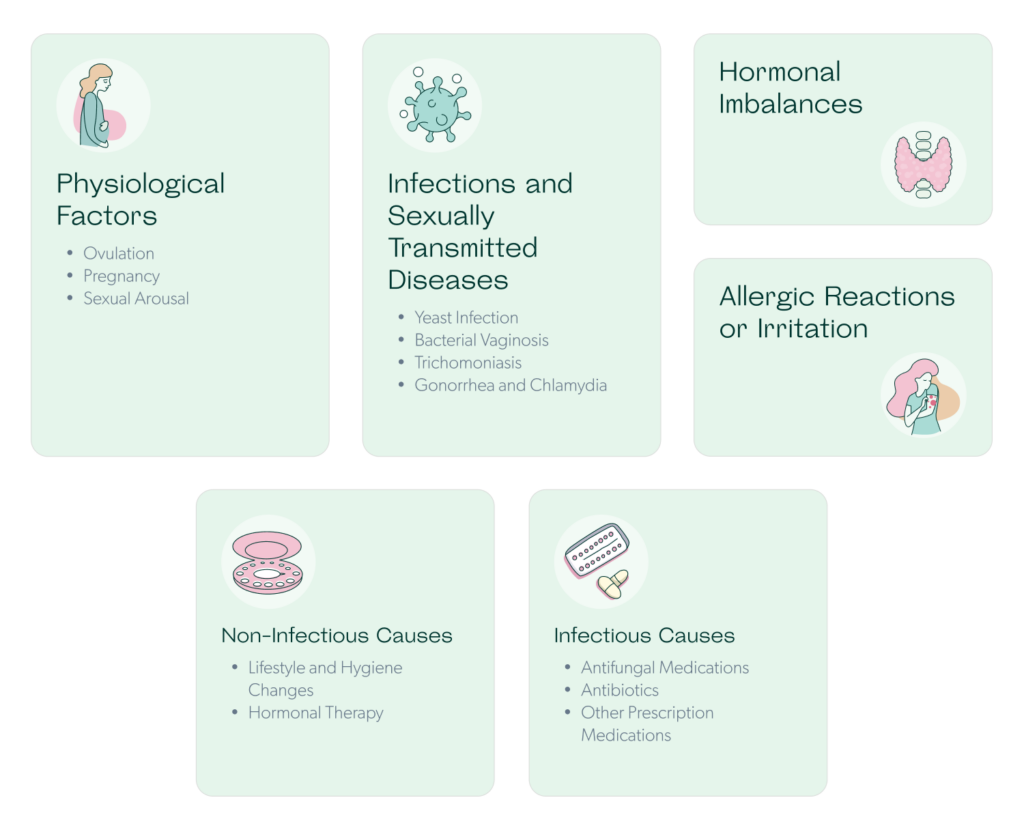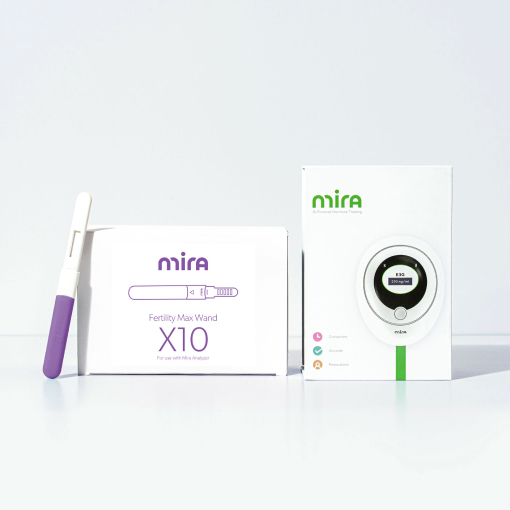White Discharge: When It’s Normal and When It’s Not
Vaginal discharge is an essential part of your reproductive system and the types of vaginal discharge you experience will vary throughout your menstrual cycle. In nearly all cases, changes in vaginal discharge are a positive sign that your reproductive system is working properly. In addition, white discharge before your period can mean your vagina is healthy, or that you may be in the early stages of pregnancy.

In this post we will explore what causes milky and egg white discharge, what it means, and when it could be a symptom of an underlying issue.
Understanding Milky White Discharge
What is milky white discharge?
Your vaginal discharge may become thinner and milky white in color after period ends. Usually, this indicates that your body is gearing up for ovulation.
Similarly, this milky white vaginal discharge can be an indicator of pregnancy. During the early stages of pregnancy, some people may experience a thinner, milky white discharge before their menstrual period. The change in cervical discharge is caused by the body’s hormones, which are preparing your body for pregnancy.
Provided that the discharge is thin and only has a mild odor, it’s most likely a sign of a healthy vagina. Thin milky white or grayish-white discharge with a fishy smell, or thick, clumpy milky white discharge, can both be signs of a vaginal infection.
Description and Appearance
Vaginal discharge can be a range of colors and many are completely normal. The texture of normal vaginal discharge can range from watery to thick and gooey. Milky white discharge is usually thicker with a creamy appearance. However, white discharge can be almost clear, milky-white, or even off-white. It may even have a slight odor to it but it should never be unpleasant.
Differentiating Milky White Discharge from Other Types of Discharge
The texture, color, smell, and amount of discharge is individual to every person that produces discharge. What’s important is if your discharge changes from what’s normal or usual for you. Sudden changes could mean something is wrong so if you notice an increase in the amount of discharge and changes in its consistency or sudden change in color (yellow, green & grey) you should speak to your healthcare provider. Similarly, if your normal discharge becomes foul smelling, there’s a change in the consistency, or these changes are accompanied by itching, pain, or burning you should get checked out.
Is white discharge normal?
The name for this discharge is leukorrhea and it’s completely normal to experience it throughout much of your menstrual cycle. Most women experience some leukorrhea during their menstrual cycle and the volume increases in early pregnancy.
Vaginal discharge helps to keep the walls of the vagina moist and help sperm travel to the cervix. The discharge is heavily influenced by the hormones in your reproductive system which is why it changes in color and consistency through your menstrual cycle and pregnancy.
The Mira fertility tracker analyzes fertility hormones and gives you specific fertility hormone concentration levels to let you know when you are ovulating or pregnant and better understand what is normal for your body.
Causes of Milky White Discharge
Physiological Factors
Discharge is perfectly normal and there are a variety of physiological factors that might cause milky white discharge.
Ovulation
If you are using a hormone tracker like Mira that can pinpoint your date of ovulation, you might realize that you have milky white discharge even though you have already ovulated. It’s normal for white discharge to last up to one or two days after ovulation.
Pregnancy
The good news if you are trying to conceive white discharge a few weeks after ovulation may be a sign of early pregnancy. Leukorrhea is the name given to the discharge that appears in early pregnancy and this discharge can be milky white in color, but may also be clear.
While this discharge is usually milky white in color, it may also be thin, clear, and slippery like egg white discharge — which can lead to confusion about whether or not you are pregnant while experiencing this discharge. Vaginal discharge can also increase in volume in early pregnancy, making it resemble your discharge around ovulation.
This change in vaginal discharge is caused by hormonal changes in the early days of pregnancy. Your vaginal discharge plays an essential role in protecting your pregnancy, by keeping harmful bacteria out of the cervix and preventing infections.
It’s important to remember that every woman’s cycle is different, and milky white discharge does not always mean pregnancy. It might be normal for you at this stage of your cycle or signify a vaginal infection — something we’ll talk about later in this blog post.
Sexual Arousal
When you are sexually aroused you may notice more discharge as it thickens and increases. This is normal and expected since this fluid helps clean, protect, and lubricate the vagina.

Infections and Sexually Transmitted Diseases
For some, milky white discharge isn’t normal and their discharge may appear clear or off-white throughout most of their menstrual cycle. Whenever your vaginal discharge does not look the way it usually does, there is a risk that you may have an infection.
Yeast Infection
When your vaginal discharge is milky white in color but is thick and clumpy in texture, it may be a sign of a yeast infection. The discharge caused by a yeast infection is white or off-white and often resembles cottage cheese.
Yeast infections are caused by an overgrowth of candida, or yeast, that grows naturally in the vagina. This can happen when the vagina is not kept clean and dry (for example, if you sit too long in a wet bathing suit) or, less frequently, due to problems with the immune system (such as diabetes). Because of hormonal changes, they are also more common during pregnancy and can indirectly affect your fertility.
Bacterial Vaginosis
Bacterial vaginosis is a common condition caused by an imbalance of normal vaginal flora. This infection can cause a change in the amount, color, and consistency of discharge.
Trichomoniasis
This infection, transmitted by sexual contact, is caused by the parasite Trichomonas vaginalis. Symptoms can range from mild to severe and you may be infected without knowing it. Your discharge may change in color and volume and can be accompanied by a soreness of genitals, painful sex, itching and burning in the vagina, the discharge can have frothy consistency.
Gonorrhea and Chlamydia
Both gonorrhea and chlamydia are common sexually transmitted infections that can change the look of your discharge. They can also cause painful urination and white discharge (among other colors).
Hormonal Imbalances
Since vaginal discharge is controlled by hormones, when they are not in balance it can cause a change to the look of your discharge.
Allergic Reactions or Irritation
Allergens, irritants, and infections can all wreak havoc on the mucosal areas of the vagina. For this reason, milky white discharge may simply be an allergic reaction or response to irritation in that region. Common irritants include detergents, soaps, lubricants, or toys but allergic reactions can also present in the vagina.
Symptoms Associated with Milky White Discharge
Itching and Irritation
Itching and irritation are common symptoms of milky white discharge. Swelling or redness around the vulva and vagina along with an itching sensation may be the first sign of something being off with your discharge. If your milky white discharge is accompanied with itching and irritation it’s time to contact your doctor.
Unusual Odor
Your vaginal odor can change day to day and throughout the month, but if it becomes foul smelling or unusual (for you), it may indicate a problem. Some infections and diseases can cause a strong smelling odor in the vagina. Not all smells are bad though and you may experience odor associated with excessive sweating or after sexual intercourse that is perfectly normal. Persistently strong odor is always worth checking out to rule out any other issues.
Pain or Discomfort
Thick white discharge may be normal for you but if it is accompanied by pain it could also be a sign of an underlying health issue. Pain or discomfort coupled with a change in your discharge is always a reason to see your doctor.
Abnormal Color or Texture
Changes in the color and texture of your discharge can also indicate a problem. Getting to know the regular colors of discharge can be helpful to understand when to seek help. It’s important to note that not all colors are bad and do not always indicate a problem. If your discharge becomes abnormal for you, it’s time to seek healthcare advice to rule out any underlying conditions.
Other Associated Symptoms
The common symptoms of problematic vaginal discharge listed above may also be accompanied by other associated symptoms. These include spotting, missing periods, rashes or sores, and a burning sensation when you pee or have sex. It’s important to see a doctor if you experience any of these symptoms along with your discharge.
Treatment Options for Milky White Discharge
Vaginal discharge and milky white discharge are completely normal and necessary parts of your health. Depending on whether the cause is infectious or not, there are some things you can do to treat milky white discharge.
Non-Infectious Causes
On the off chance that your milky white discharge is abnormal, or if you find it bothersome, there are some things you can do to get rid of it. Here are a few ways to treat or prevent milky white discharge.
Lifestyle and Hygiene Changes
There are lifestyle and hygiene changes you can make to address some causes of milky white discharge. These include changes to your vaginal hygiene and taking supplements like probiotics to naturally address pH issues.
You can prevent many infections and steer clear of excessive vaginal discharge by taking proper care of your vagina and vulva.
The vagina maintains a certain pH, which can be thrown off by hygiene products containing fragrance or chemicals. To keep it clean “down there,” use an unscented, gynecologist-tested soap on the vulva only. You should never use scented sprays or douches, nor should you ever wash inside the vagina.
You can also maintain proper vaginal hygiene by keeping the vagina dry. Always change out of swimsuits and sweaty gym clothes ASAP to prevent yeast infections, as yeast can overgrow when the vagina is in a damp environment. You should also wear 100% cotton underwear to keep the vagina clean and dry.
Lastly, vaginal hygiene should always include using a barrier method — such as a condom or dental dam — during sexual activity. Other forms of birth control, like the oral contraceptive pill, do not protect against STIs, so you need to use a barrier method anytime you engage in sexual activity with a new partner.
If you struggle with recurrent vaginal infections or other discharge issues, it can help to enrich your diet with probiotics. These beneficial organisms grow naturally in the vagina and help maintain a healthy pH.
You can find probiotics in certain foods and yogurt, kimchi, sauerkraut, and other fermented foods are filled with them. You can also take a dietary supplement containing probiotics.
Probiotic supplements are sold over-the-counter at many drugstores and supermarkets. You should look for a probiotic containing Lactobacillus acidophilus, which comprises most of the vaginal flora. The best probiotics have over one billion colony-forming units (CFUs) of live probiotics. Keep them in the refrigerator to extend their shelf life.
Hormonal Therapy
When the cause of your milky white discharge is due to a change in hormones, hormonal therapy may be one line of defense. Hormonal changes can happen in pregnancy, during your menstrual cycle, and during menopause. Always speak with your doctor to discuss the right kind of hormonal therapy for you and your milky white discharge.

Infectious Causes
When milky white discharge is caused by an infection, the only way to treat it is with the appropriate medication.
Antifungal Medications
The treatment for yeast infections is an antifungal medication. You can purchase intravaginal antifungal medication at the drugstore. Or, if you would rather take a pill, you can see your doctor for a prescription.
Antibiotics
If you are dealing with a STIs like chlamydia or gonorrhea, you will need to take antibiotics, which are only available via prescription. Sometimes, you may be able to get relief in as little as one dose of antibiotics.
Other Prescription Medications
The choice of medication used to treat milky white discharge will depend on the cause of the discharge. Popular prescription medications include antibiotics and antifungals. These can come in the form of a pill, cream, or suppository.
Alternative Remedies and Natural Treatments
There are a variety of natural remedies and treatments found on the internet to relieve milky white discharge. Many remedies are aimed at changing the natural balance of bacteria in the vagina through foods like yogurt that naturally contain probiotics. What you eat can contribute greatly to the overall health of your vagina. Many times these treatments are used as a complement to your doctor’s treatment.
Follow-up Care and Prevention
If you have successfully treated the reason for your milky white discharge, no follow up care is needed. Always take the full course of medicine prescribed to you, even if symptoms disappear.
There is no way to prevent vaginal discharge since it’s part of a healthy functioning reproductive system. Managing excessive discharge may be as easy as wearing a panty liner but if there is an underlying medical reason, your healthcare provider can help manage things.
What does white discharge mean for fertility and pregnancy?
Thin, milky white discharge can be a sign that you are approaching your fertile window — or even that you are pregnant. To tell the difference, it’s important to pay attention to timing.
If you experience milky white discharge after your period, prior to the middle of your cycle, it may be a sign that you are approaching ovulation. For someone who is trying to conceive (TTC), that might mean it is a good time to have sex.
Alternatively, thin, milky white discharge after ovulation but before your period might be a sign of early pregnancy — especially if you are having more vaginal discharge than usual. If you experience a greater volume of milky white discharge than usual, take a pregnancy test on the first day of your next expected period to confirm.
Of course, charting your vaginal discharge can only provide an estimate of fertility and potential pregnancy. The best way to know for sure if you are fertile or pregnant is to use a hormone tracker like Mira, which measures your exact fertility hormone concentrations.
What does white discharge mean for vaginal health?
Most of the time, milky white discharge, or leukorrhea, is a sign that your vagina is happy and healthy. Leukorrhea — the white, off-white, or clear discharge you experience throughout your menstrual cycle — helps maintain a healthy vaginal pH by keeping out bacteria and preventing infections.
There is a broad spectrum of what is considered normal when it comes to vaginal discharge. Normal vaginal discharge can be milky white, off-white, or clear. When you are most fertile, it may be thin or stretchy, like the white of an egg. When you are less fertile, it can be thick and creamy like paste, or even crumbly in texture.
Abnormal signs and symptoms to pay attention to include a foul odor, unusual color (including gray, green, or bright yellow discharge), or odd texture (such as frothy or cottage cheese-like discharge). These can be signs of vaginal infections like a yeast infection, bacterial vaginosis, or an STI.
When should you see a doctor about white discharge?
Unless you notice any unusual signs or symptoms, you should assume that vaginal discharge is normal, healthy, and nothing to worry about. Some of the signs and symptoms to keep an eye out for include:
- Thin, watery gray or brown discharge with a fishy odor
- White, yellow, or bloody discharge with a foul odor
- Thick, white, cottage-cheese like discharge
- Discharge that significantly differs from your usual vaginal discharge
- Itching or burning of the vagina and/or vulva
- Painful urination and/or sexual activity
Anytime you notice one of the above symptoms, it’s important to visit your OB/GYN to get it checked out. Most of the time, changes in vaginal discharge are nothing serious. Even if they do signify an infection, these infections are treatable and shouldn’t cause any damage to your health or fertility — as long as you treat them promptly.
FAQ
Is milky white discharge normal?
The name for this discharge is leukorrhea and it’s completely normal to experience it throughout much of your menstrual cycle. Most women experience some leukorrhea during their menstrual cycle and the volume increases in early pregnancy.
Vaginal discharge helps to keep the walls of the vagina moist and help sperm travel to the cervix. The discharge is heavily influenced by the hormones in your reproductive system which is why it changes in color and consistency through your menstrual cycle and pregnancy.
The Mira fertility tracker analyzes fertility hormones and gives you specific fertility hormone concentration levels to let you know when you are ovulating or pregnant and better understand what is normal for your body.
What does milky white discharge indicate during pregnancy?
Many women notice leukorrhea, or milky white vaginal discharge, in early pregnancy. For many women, leukorrhea is the earliest sign that they are pregnant.
While this discharge is usually milky white in color, it may also be thin, clear, and slippery like egg white discharge — which can lead to confusion about whether or not you are pregnant while experiencing this discharge. Vaginal discharge can also increase in volume in early pregnancy, making it resemble your discharge around ovulation.
If you have recently had unprotected sex and notice an increasing amount of white discharge a few weeks after ovulation, make sure to take a pregnancy test on the first day of your next expected period to see if you are pregnant.
Can stress cause milky white discharge?
Yes! Stress can cause hormonal changes in the body that can lead to milky white discharge. Chronic stress and the continued production of stress hormones can lead to hormonal imbalances that can affect your discharge.
Can hormonal birth control affect vaginal discharge?
Because of the hormones they contain, hormonal birth control can lead to changes in your vaginal discharge. Many who take this form of birth control experience whitish discharge throughout the month as the hormones thicken cervical fluid.
How long does a yeast infection last?
The amount of time a yeast infection lasts depends on both the severity of your infection and when you sought treatment. Mild infections may only last a few days while moderate to severe infections can take as long as two weeks to resolve.
What are the possible complications of untreated bacterial vaginosis?
Although untreated bacterial vaginosis doesn’t usually cause other issues, left untreated it can leave you at a higher risk for some health issues including certain STIs, pelvic inflammatory disease, and early labor or birth (if pregnant).
Can milky white discharge be a sign of an STIs?
Yes. Milky white discharge is not always a sign of an STIs but many infections cause discharge.
What are the risk factors for developing vaginal infections?
Risk factors for developing vaginal infections include taking antibiotics, hormonal contraceptives, contraceptive devices, a weakened immune system, sexual activity, and diabetes.
How can I prevent milky white discharge?
Milky white discharge that is part of your regular vaginal discharge cannot be prevented. It’s a healthy part of your reproductive system and perfectly normal. Excessive discharge can be managed by your healthcare provider to rule out any underlying causes.
Recommended for you
Navigate your fertility with peace of mind
Mira’s Editorial Process
All content produced by Mira meets stringent editorial standards, ensuring excellence and accuracy in language and medical precision. Every piece undergoes thorough fact-checking and review by qualified professionals. Check out our full editorial process to learn more.














